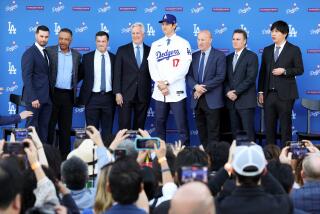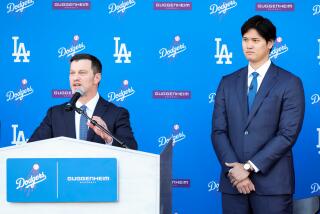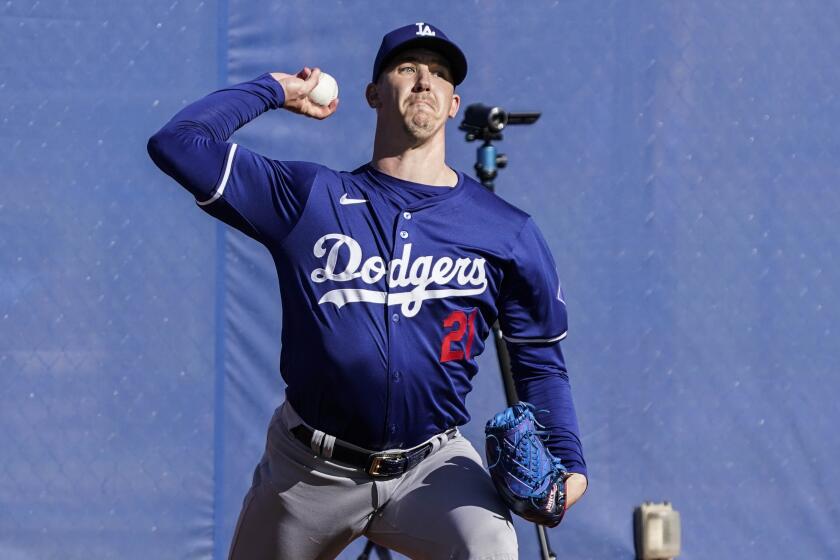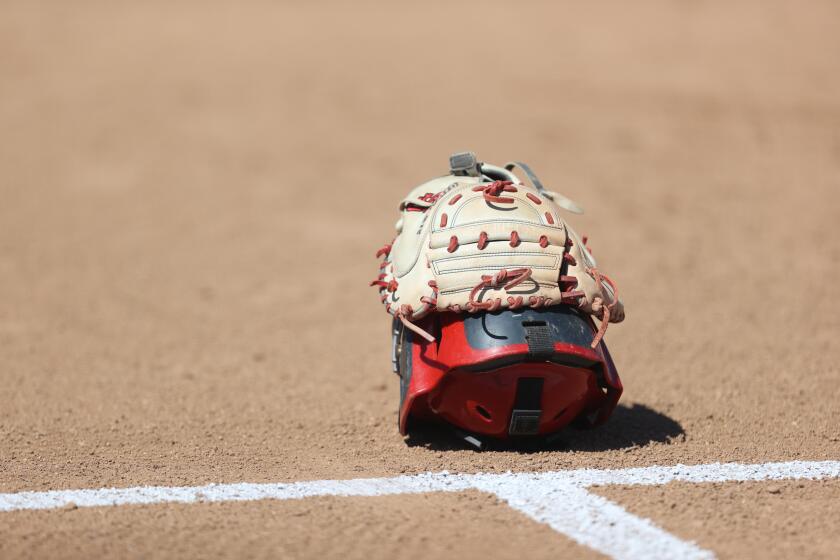Influx of Cuban players to MLB could increase steadily
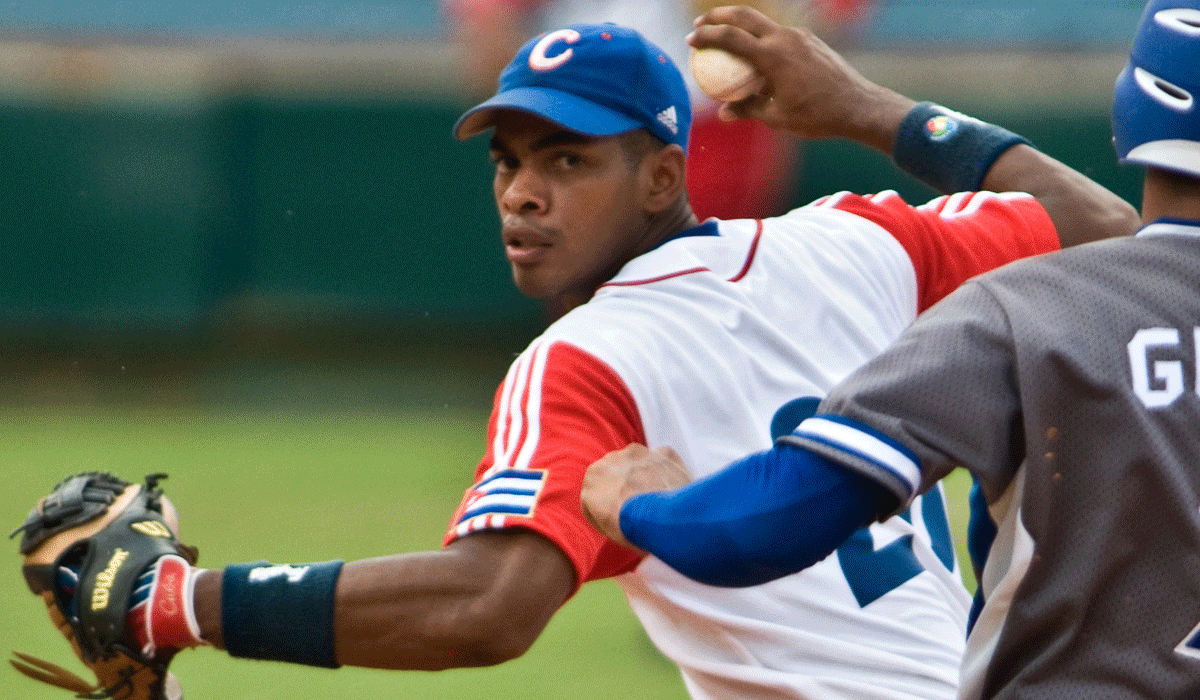
The Dodgers spent $62.5 million on 30-year-old Cuban infielder Hector Olivera, shown in 2010, during the off-season.
In the not-too-distant future, the Dodgers could field a lineup with Cuban-born players at catcher, second base, third base and right field.
Cuban players such as Dodgers outfielder Yasiel Puig, Cincinnati Reds closer Aroldis Chapman and Chicago White Sox slugger Jose Abreu have quickly become stars in the major leagues, and now a thaw in relations between the governments of Cuba and the United States could turn the trickle of talent from the baseball-crazed Caribbean island into a steady stream.
The stakes are high. The risks are great. The rewards could tilt baseball’s balance of power.
In February, the Boston Red Sox signed Cuban infielder Yoan Moncada, a teenager, for $62 million. One month later, the Dodgers spent $62.5 million on 30-year-old Cuban infielder Hector Olivera.
The money has become so great that baseball executives are debating the process by which Cuban players are acquired, currently an auction, is fair to all the teams.
There is also a question about whether Cuba truly represents the next great talent pipeline to the major leagues. There were 18 Cuban-born players on opening-day rosters this season, a distant third among foreign countries to the Dominican Republic (83) and Venezuela (65).
The population of Cuba and the Dominican Republic is similar, about 11 million each, so the Cuban presence in the majors could rise if Major League Baseball teams are allowed to send scouts to the island and ballplayers are allowed unrestricted movement. But until then, big league clubs may struggle to assess how deep the talent pool is and what resources — equipment, instructors, facilities and the like — are required to develop it.
“No one knows,” said Chris Antonetti, Cleveland Indians general manager. “To have a sense of what the 16-year-old talent in Cuba looks like? I don’t have a sense.”
Although the U.S. and Cuban governments are working to restore political and economic relations, MLB enforces the current U.S. embargo by prohibiting its teams from scouting in Cuba. As a result, major league teams generally are limited to scouting Cuban players in international tournaments or in workouts held by players who have defected or otherwise left the island.
“We’ve got a better idea about a college player at UC Riverside than we do about a professional player in Cuba,” said Jerry Dipoto, Angels GM.
The Angels expect to spend about $5 million this year to sign players selected in the draft this month. They invested more than three times that much in December to sign 21-year-old Cuban infielder Roberto Baldoquin.
The disparity exists because draft picks can negotiate only with the team that chose them. Cuban players are free agents, once they establish residency in a third country.
A Cuban player with five years experience — like Olivera, the infielder who could join the Dodgers any day now — is considered a free agent and can sign with any MLB team, at any price. Cuban players with less experience also are free agents but are subject to MLB restrictions intended to limit spending on Latin American prospects. Each team is assigned a total amount it can spend on international prospects, with stiff financial penalties for exceeding that amount.
The Red Sox were assigned $1.9 million for the current signing period. They spent $31.5 million on a bonus for Moncada and $31.5 million in MLB penalties because they spent more than their allotment. In doing so, the Red Sox blasted open one of baseball’s shrinking number of loopholes and a rich team got richer in baseball talent.
“International is one of the remaining areas where teams can, if they’re wealthy and can bear the brunt of a penalty, flex their financial muscle,” said Rick Hahn, Chicago White Sox GM.
The wave of ballplayers leaving Cuba in recent years was triggered not by a thaw in U.S.-Cuban relations but by the reach of technology, according to Joe Kehoskie, a former agent for Cuban players who is a baseball industry consultant.
For decades, players on the Cuban national team were glorified as state heroes, with tournament victors rewarded with huge stories in the state-controlled media, a few extra dollars — Puig reportedly was paid $17 a month — and a modest upgrade in residence. Although satellite dishes and Internet access remain rare in Cuba, players could sneak enough of a peek at the outside world to see that the path to financial glory required leaving the country, Kehoskie said.
“They said, ‘Why would you spend your good years here, trying to make the Cuban national team and have a slightly bigger house, when you can go to the States and have a mansion?’ ” Kehoskie said. “Once players started to see that, it became all but impossible for Cuba to hang onto them.”
Yasmani Grandal, the Dodgers’ catcher, left Cuba at 10 after his family won a U.S. lottery that provided legal residence to Cubans. For established Cuban stars, the most common escape route involves defection, typically at great risk to the player and any family left behind.
Alex Guerrero, who plays third base and left field for the Dodgers, escaped on his third try. Puig, the Dodgers’ right fielder, escaped on his fifth try, in a compelling and sordid tale of a speedboat, human smugglers and drug cartels.
When President Obama announced in December his intention to normalize relations with Cuba, the New York Post wrote about the potential effect on baseball with this headline: “Dozens more Puigs?”
Said Kehoskie: “There probably isn’t a single Puig left in Cuba, let alone dozens. The cupboard is just about bare when it comes to major league-ready players.”
That could be why the Red Sox raised more ire for their $62-million deal with Moncada, 19, than for their $72.5-million deal for outfielder Rusney Castillo, who qualified as a major league free agent.
The Dodgers paid Olivera more than any major league free agent they signed last off-season. And, when the new signing period for Latin American prospects opens July 2, the Dodgers, proprietors of the most expensive payroll in North American sports history, are expected to spend many times more than their assigned limit and shrug off the penalties.
Said Doug Melvin, Milwaukee Brewers GM: “I don’t think the financial penalties give everybody a fair chance. They don’t deter clubs. That 100% penalty doesn’t seem to scare off a lot of teams.”
It did not scare off the Angels, who paid $8 million to sign Baldoquin and $8 million in the MLB tax. Baldoquin, who is playing at Class-A Inland Empire, is under club control for several years.
“I don’t think the system is broken,” Dipoto said.
Said Jon Daniels, Texas Rangers GM: “In my mind, for what Moncada signed for, any club could have had him. I don’t think there’s any team in baseball that hasn’t made a $60-million commitment.
“Obviously, it’s easier for the Dodgers and other big-market clubs. You can’t count any team out. It comes down to opportunity, cost, evaluation of the player and what else you can do with those resources.”
Melvin, whose Milwaukee club operates in the smallest market in the major leagues, saw an opportunity in Moncada. The Brewers offered him a much quicker path to the majors than did the Red Sox. The Brewers also offered less than $20 million — they were prepared to go higher, Melvin said, but were “blown out of the water.”
Nothing new, he said, in a rich team spending its way to what it wanted.
“Before my time, the [New York] Yankees were accused of it,” Melvin said. “Now the TV money has made a huge difference. Every day you see another team with a huge new TV contract.”
Rob Manfred, who is in his first year as baseball commissioner, said the tax has not yet been an effective deterrent but that teams such as the Angels, Red Sox and Yankees, who already exceeded their international signing budget, have yet to suffer the full penalty — the inability to spend more than $300,000 on any international player for the two subsequent years.
“That is going to be a fairly large handicap,” Dipoto said. “The volume of talent coming out of Cuba gives you the option to spend now and sit on your hands for a while.
“If you wanted to play on these players, you have to play now. I don’t think there is going to be a constant flow of 20 to 40 Cuban players hitting the shores of Major League Baseball every year. I believe this is a one-time buying opportunity.”
More to Read
Get our high school sports newsletter
Prep Rally is devoted to the SoCal high school sports experience, bringing you scores, stories and a behind-the-scenes look at what makes prep sports so popular.
You may occasionally receive promotional content from the Los Angeles Times.


